Black Light Tattoos, also known as UV tattoos, offer a unique twist on body art. Invisible in daylight, they reveal themselves with a vibrant glow under ultraviolet light, creating a captivating secret for those in the know. Forget childhood glow-in-the-dark star stickers; black light tattoos utilize special UV-reactive ink to achieve their luminous effect, making them a popular trend for those seeking something subtly extraordinary.
Understanding Black Light Tattoos: More Than Just Glow-in-the-Dark
It’s crucial to understand that black light tattoos don’t glow in the dark like phosphorescent materials. Instead, the magic happens under a black light, where the UV-reactive ink comes alive. This distinction is key for anyone considering this type of tattoo, ensuring realistic expectations and appreciation for their unique nature. Think of them as a hidden layer of art, revealed in specific lighting conditions.
The Growing Popularity of UV Tattoos
Black light tattoos are surging in popularity within the tattoo community. Their appeal lies in the blend of subtlety and surprise. They can enhance existing tattoos, adding an unexpected element, or stand alone as minimalist designs that only reveal their full beauty under UV light. Imagine a constellation of stars that appear only under black light, or intricate details within a traditional tattoo that pop with a neon glow. The creative possibilities are vast, making them a sought-after choice for those wanting to push the boundaries of conventional tattooing.
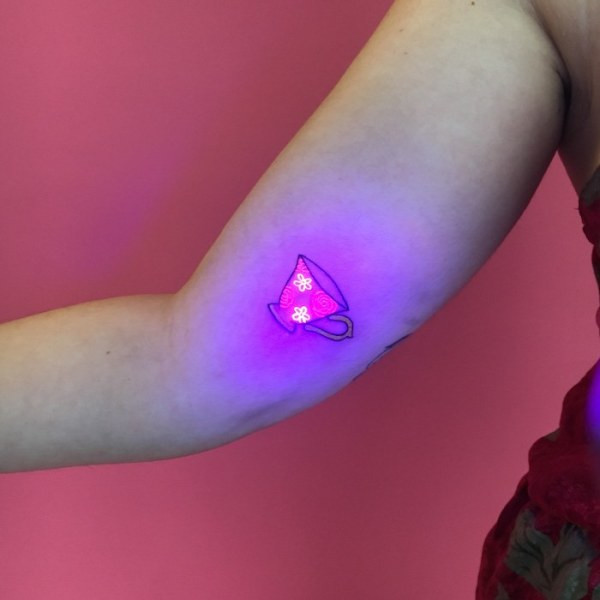
Tattooing with UV Ink: A Different Process
Working with UV ink presents unique challenges for tattoo artists. Compared to traditional tattoo ink, UV ink is often thinner and more translucent. This requires experienced artists who understand the nuances of this medium. Precision and technique are paramount to ensure the design is not only visible under black light but also heals correctly and looks aesthetically pleasing in normal light, even if subtly.
To gain deeper insights into the process, we spoke with experienced black light tattoo artists about their techniques and considerations:
How Does the Black Light Tattoo Process Differ from Regular Tattoos?
Quinton McCloud from Karmic Tattoo in South Atlanta emphasizes a cautious approach, especially when starting with UV inks. “Because it was my first time doing it, I just wanted to test it out by putting a little here and there,” McCloud explained, highlighting his initial experimentation to avoid over-saturation. His first UV tattoo, a gecko with a party hat, strategically used UV ink for details like fingernails and confetti, demonstrating a thoughtful application of the glowing ink.

McCloud’s journey into UV tattoos was initially met with skepticism during his apprenticeship due to concerns about ink quality. “I asked him why I never really saw or heard of anyone getting them, and he told me that the only place you could get UV ink at the time was from sources that weren’t really trustworthy tattoo suppliers, like eBay and Amazon,” he recounted. However, the emergence of reputable UV ink lines like Kuro Sumi Glow changed the landscape, providing artists with safer and higher-quality options.
For a more experimental piece, McCloud tattooed a Xenomorph-inspired mouth using vampire teeth, utilizing different needle types. “With the teeth, I used a shader on the whole thing and it got super irritated in the skin,” he noted, pointing out the potential for increased skin sensitivity with UV inks, even with low machine settings.

Kayla Newell from Secret Club Tattoo in Portland, Oregon, shares a cautionary tale from her early experiences with UV ink. “My first blacklight tattoo was self-administered and done using this terrible quality UV pink ink that I found on Amazon,” she admitted. “It was some Skin Candy knock-off brand that I think I bought because it was the cheapest shit on there. It definitely shows,” Newell added, emphasizing the importance of sourcing reputable inks. While her DIY tattoo still glows faintly, she strongly advises against using low-quality, unverified inks.
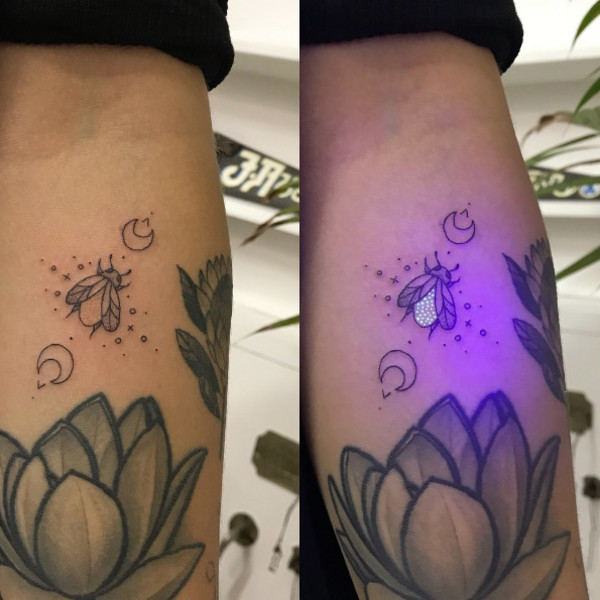
Adapting Tattoo Techniques for UV Ink
Tukoi Oya, an Australian tattoo artist, brings a “rave til the grave” energy to UV tattooing, highlighting the need for technique adjustments due to ink consistency. “The consistency of the brand I use is pretty thin and opaque, so when you’re doing solid patches of color you need to be really careful not to overwork the skin, because it feels like more of a grey wash than normal color to apply,” Oya explained. This delicate balance is key to achieving vibrant results without damaging the skin.
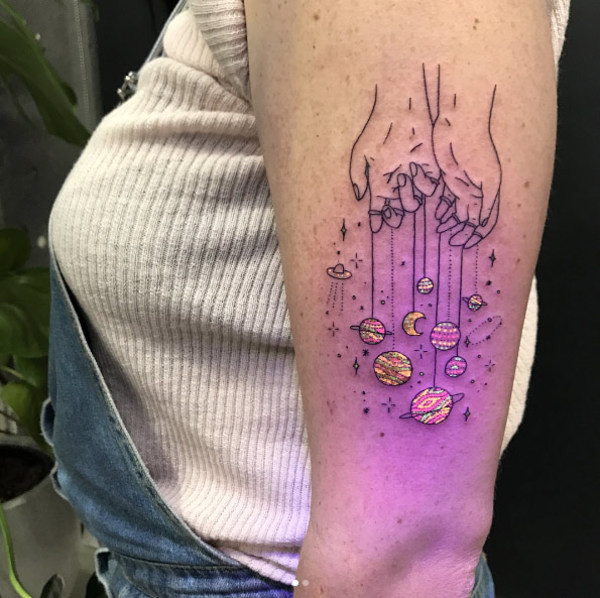
Oya also points out the subtle healed appearance of UV tattoos, describing it as “pastel and watered-down,” with the phosphorus potentially visible. She favors lighter UV ink colors like yellow, pink, orange, and green, noting that “the purples and blues do not reflect as bright with the UV light because they’re darker pigments.” For aftercare, Oya recommends Dr. Pickles, especially for fine-line UV tattoos.
Samantha Ceora from Ceora Ink in LA highlights the importance of preventing stencil contamination to maintain the “invisible effect” of UV tattoos. “The tattoo is done with a plastic disposable tip to avoid any discoloration. I also remove the stencil almost completely to avoid any trace of the ink contaminating the tattoo. The machine has to be turned down low and a uv light must be used periodically throughout the process,” Ceora detailed. This meticulous approach ensures the tattoo remains discreet in normal light.
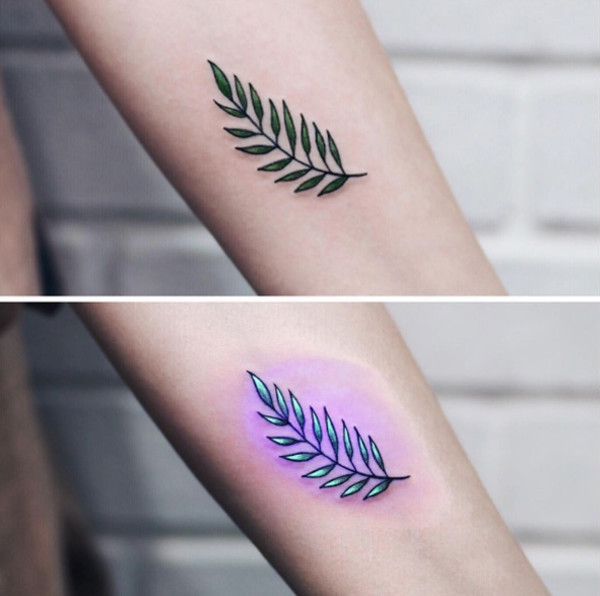
Ceora also stresses minimizing skin trauma. “One last thing is I make sure to get the ink in 1-3 passes max, to ensure the skin’s safety from scarring. After all, the whole point is to create an invisible tattoo.”
Newell echoes the similarity in the tattooing process but emphasizes the unique properties of neon UV inks. “The neon inks I use are pretty thick, much like white ink, so you have to be careful that it doesn’t separate or mix with any other colors once it’s been laid in,” she advised. Contamination with darker pigments, even smearing, can diminish the ink’s glow.
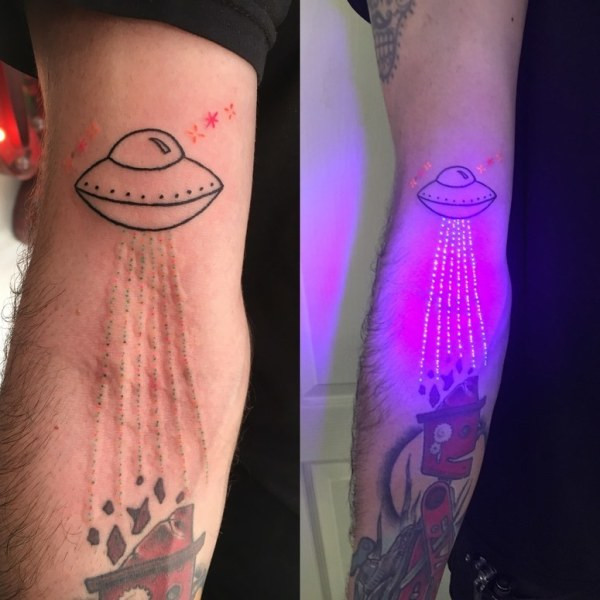
Design Ideas for Black Light Tattoos
When it comes to design, black light tattoos offer exciting possibilities. Artists suggest that less is often more, and strategic placement of UV ink can create the most impactful results.
What Tattoo Styles Work Best with UV Ink?
Tukoi Oya suggests a minimalist approach: “I feel like when you add some UV here and there it looks best. Don’t go overboard with it. I find it looks best just doing small dots or small sections of color though.” This highlights the effectiveness of using UV ink as accents rather than for large blocks of color. Oya also advises careful technique to avoid staining the skin during healing, similar to the considerations for white ink tattoos.
Newell favors bold designs, stating, “Anything really bold looks good in neon, especially when it’s done right next to a dark color, so that it pops. That’s why I like doing the 3-D effect in black and pink or blue and red.” This suggests that UV ink can be particularly striking when combined with dark, contrasting inks, creating depth and visual interest.
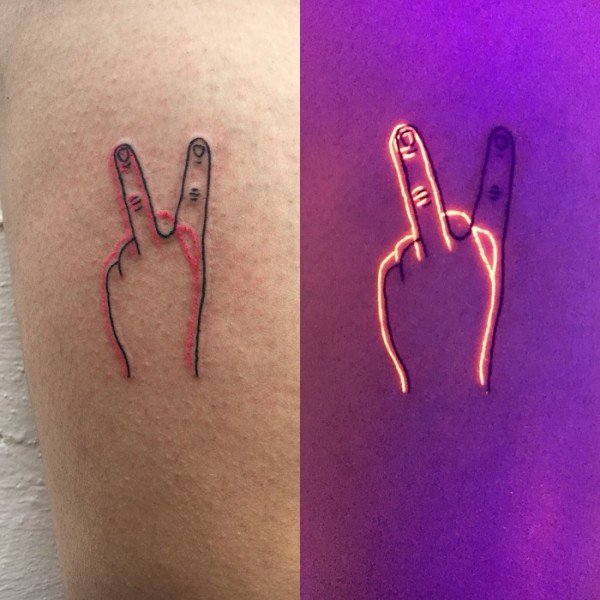
Black Light Tattoo Aftercare and Longevity
Proper aftercare is crucial for all tattoos, and black light tattoos are no exception. Artists recommend standard tattoo aftercare practices to ensure optimal healing and longevity of the UV ink.
Healing and Aftercare: Is it Different for UV Tattoos?
Samantha Ceora’s aftercare routine includes layering ink after tattooing and using a SecondSkin bandage. “Usually I will layer some ink on top of the tattoo after finishing, and use SecondSkin bandage to seal it for 4-24 hours so the skin holds the ink.”
Kayla Newell emphasizes that aftercare is “exactly the same in every way” as for traditional tattoos, simplifying the process for clients. Newell uses reputable ink brands like Waverly Colors and Northwest Pigments, underscoring the importance of quality materials in both the tattooing process and aftercare outcomes.
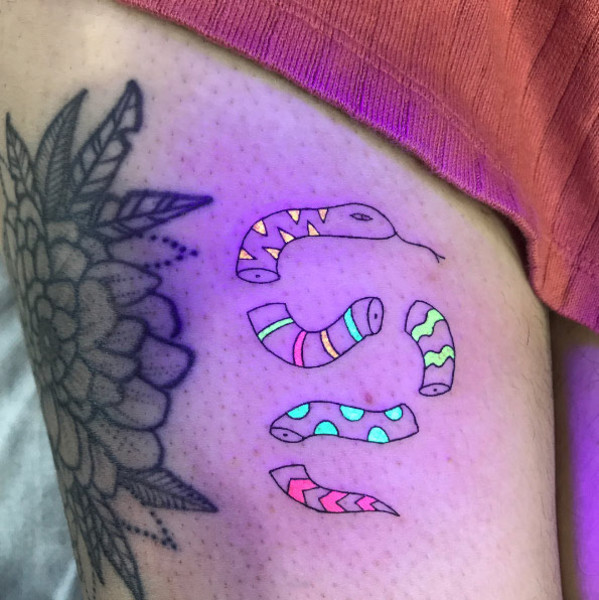
How Long Do Black Light Tattoos Last?
The lifespan of black light tattoos can vary. Ceora notes, “I’ve seen them last years. Though, it’s kind of a gamble. Everyone’s skin is different. The aftercare instructions need to be taken seriously and gently. Anyone considering a UV tattoo should seek out an experienced artist with the ink.” This highlights the individual nature of tattoo longevity and the impact of artist experience and aftercare.
Tukoi Oya estimates a lifespan of around 5 years, with gradual fading over time, similar to regular tattoos. However, she also shares anecdotal evidence of UV tattoos remaining vibrant after a year and a half, suggesting that longevity can be influenced by various factors, including ink quality, technique, and individual skin.
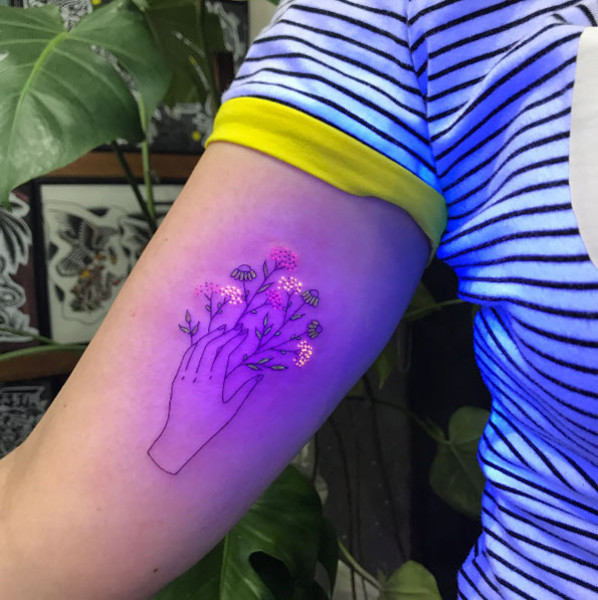
Safety and Side Effects of UV Tattoos
Safety is a paramount concern in tattooing, and black light tattoos are no different. While the FDA hasn’t approved any tattoo inks, concerns regarding UV inks often center around their composition and potential long-term effects.
Are There Risks Associated with Black Light Tattoos?
It’s important to note that the U.S. Food and Drug Administration (FDA) has not approved any tattoo inks, including UV inks, for injection into the skin. The FDA points out that “many pigments used in tattoo inks are industrial-grade colors suitable for printers’ ink or automobile paint,” raising general awareness about tattoo ink safety.
Concerns specific to UV inks often revolve around ingredients like phosphorus, used to achieve the glowing effect. Dermatologist Arash Akhavan from New York City notes, “Phosphorus is a popular ingredient to achieve the glow-in-the-dark effect, and there are some concerns that in high doses it can be carcinogenic.” This highlights a potential, though not definitively proven, long-term health risk associated with phosphorus-based UV inks.
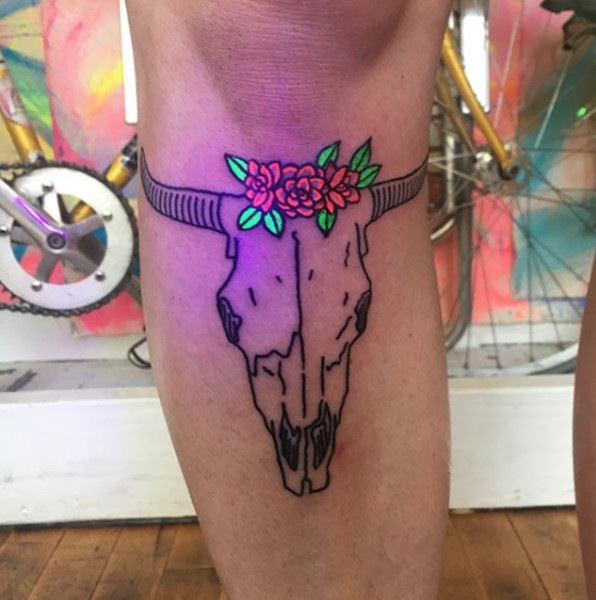
Ceora shares her experience with adverse reactions, stating, “I have only seen one out of 25 people have a bad reaction. They had some scarring and irritation, and loss of glow.” She attributes this instance to her earlier inexperience, ink brand, and the client’s allergies, suggesting that artist experience and ink quality play a significant role in minimizing negative reactions.
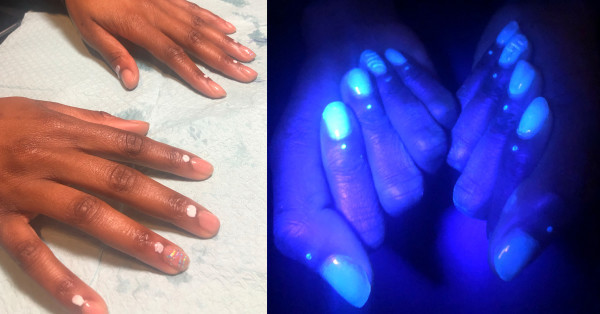
Tukoi Oya, who uses Firefly ink from Protat, a major Australian supplier, acknowledges the lack of FDA approval but emphasizes the positive healing experiences she’s observed. She counters concerns about phosphorus by pointing out its presence in everyday items: “There is phosphorus in so many things though, like washing powder, paper, and even some foods like potatoes. Literally anything that glows with a black light.” Oya’s perspective encourages a balanced consideration of risks, acknowledging potential concerns while also noting the widespread presence of phosphorus in the environment.
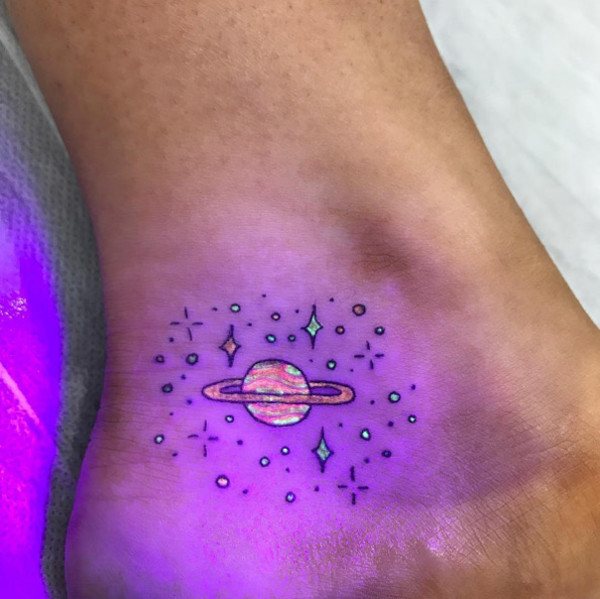
The Allure of Black Light Tattoos
Ultimately, the appeal of black light tattoos lies in their unique blend of visibility and invisibility, mystery and reveal. They offer a personal secret, a hidden artwork that comes to life under specific lighting conditions.
Why Choose a UV Tattoo?
Kayla Newell perfectly captures the artistic motivation behind UV tattoos: “When I first started tattooing I really wanted to make stuff that looked like my paintings; abstract, geometric and wild colors. I had bought this ink at the local supply shop that was the most vivid, brightly colored neon pink I had ever seen and I already knew it would glow under blacklight just from the naturally fluorescent quality.” Her artistic vision sought to translate her painting style to tattoos, and UV ink provided a medium to achieve vibrant, unique effects. Newell also aimed to dispel misconceptions surrounding UV tattoos, differentiating them from harmful “glow-in-the-dark” tattoos and emphasizing the availability of safe, black light-reactive inks.
Newell concludes by highlighting the sheer magic of seeing a UV tattoo glow: “Aside from that, the act of seeing yourself glow under a blacklight is pretty magical, and that is hard to deny once you’ve seen it in real life.” This encapsulates the core allure of black light tattoos – the enchanting experience of revealing hidden art on your skin, a personal and captivating secret that glows.

